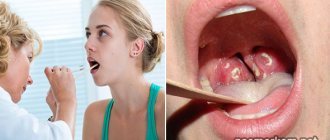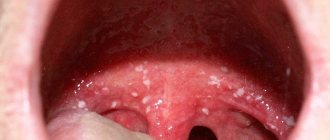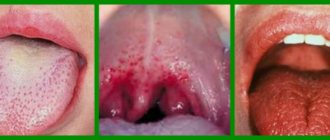Effective rinsing solutions
• Water with salt, soda.
Dilute 1 teaspoon of salt and soda in a glass of water. You can add a little iodine there, which will have a disinfecting effect. • A solution of chlorhexedine, which has antiviral and antimicrobial activity. It fights well against pharyngitis, streptococcal, and staphylococcal infections.
• Chlorophyllipt is a green alcohol solution for getting rid of staphylococcal and viral infections. They are also good for treating laryngitis, pharyngitis, and sore throat.
• Propolis – helps in case of bacterial sore throat. Drops of propolis tincture are dissolved in 100 ml of water (you can buy it at the pharmacy).
• Medicinal herbs that have bactericidal and anti-inflammatory effects. These include: St. John's wort, calendula, chamomile, eucalyptus, oregano, raspberry leaves, sage. You can use these herbs individually or as a whole collection.
Remember, dear friends. Self-medication for such diseases is unacceptable. Every pimple on the mucous membrane of the throat requires treatment by a professional who can accurately determine the cause of its appearance and prescribe the correct therapy. Be healthy!
Children get sick often, and this is largely due to imperfect personal hygiene, close contact with other children or adults who are sources of infection, as well as the immaturity of the immune system, as a result of which the body becomes susceptible to viruses and bacteria. Redness of the mucous membrane of the pharynx and tonsils is a persistent sign by which a person examining the throat of a sick child can judge the presence and severity of the inflammatory process. Often, parents and practicing pediatricians are faced with cases of classic pharyngitis and tonsillitis, but if the pimples in the child’s throat have a reddish tint, the approach to diagnosis will be different.
Throat diseases are a broad concept, since it includes a whole group of heterogeneous pathologies that can be caused by both viruses and bacteria, and pathogenic fungi (mycoses). The “throat” in the generally accepted sense includes the pharynx, lymphoid formations - the tonsils, and sometimes the larynx, located next to the pharynx. Since during a visual examination without special devices one can see mainly the back wall of the pharynx and the palatine tonsils, complaints about rashes are usually explained by damage to these anatomical areas.
A rash in the throat in children is a symptom that can only be called relatively specific. Rashes such as spots, nodules or blisters (vesicles) are not characteristic of the typical form of pharyngitis or tonsillitis (sore throat), and these diseases are the most common. Damage to the mucous membrane, accompanied by the appearance of vesicles, is observed during infection with herpes group viruses, enteroviruses that cause:
- herpangina;
- chicken pox;
- herpetic stomatitis.
Pimples in the throat are usually explained by an infectious process.
However, at the same time, other changes that are present in banal (simple, classical) forms of inflammatory processes can be mistaken for a rash. The diseases named in the list are characterized by a blistering rash, often with clear or cloudy exudate, rather than elements resembling pimples or pimples. Therefore, diagnosis should be carried out by a specialist familiar with the features of changes in the mucous membrane of the oropharynx in various pathologies.
It is also necessary to distinguish between infectious and inflammatory pathologies that occur acutely or chronically, provoked by viral or microbial agents. For example, white bumps in the throat may indicate a bacterial throat infection called bacterial pharyngitis. The etiology of the disease during the infectious process determines the choice of treatment, so timely and high-quality diagnosis is necessary for successful recovery.
Why might red formations resembling pimples appear in a child’s throat? This occurs as a result of the development:
- Acute infectious pharyngitis.
- Chronic hypertrophic pharyngitis.
These diseases are caused by an inflammatory process within the boundaries of the pharynx and are most often caused by respiratory viruses or bacteria (streptococci, staphylococci). We cannot exclude the possibility of simultaneous damage to the tonsils (tonsillopharyngitis), which is often observed in children, especially in the younger age group.
Scarlet fever
The causative agent of this infectious disease is hemolytic streptococcus, which causes inflammation of the oral mucosa. Infection occurs 2–3 days after contact with a patient with tonsillitis, pharyngitis, or a carrier of the bacteria.
The first signs of scarlet fever are fever and sore throat. The next day, a rash appears on the cheeks, folds of the arms and legs, and sides of the body. A feature of the skin lesion is a white nasolabial triangle, untouched by the rash.
A characteristic sign of infection is the appearance of pimples on the back of the throat in the form of a red, pinpoint rash.
Note! On the second or fourth day of illness, the patient’s tongue becomes “crimson.” Its papillae enlarge and become bright red, giving the tongue a grainy appearance.
The tonsils are inflamed, covered with purulent plaque, and painful when swallowing.
The main treatment for scarlet fever is antibiotics - Amoxiclav, Phenoxymethylpenicillin, Ampicillin for 7-10 days. The infection is usually mild. But rapid improvement is not a reason to discontinue the drug.
Streptococcus is destroyed in the body only with a full course of treatment. Otherwise, the patient will be its carrier, posing a danger to the family. Additionally, B vitamins and ascorbic acid are prescribed.
The most common cause of candidiasis is decreased immunity. Therefore, thrush often occurs in the mouth of infants. Thrush is characterized by pimples in the throat, covered with a white cheesy coating. The spots are localized on the tongue, behind the arches, tonsils and soft palate.
Important symptom! After removing the top layer, small erosions are visible, from which droplets of blood are released. The rashes cause discomfort to patients.
- pain and dryness in the throat;
- itching and burning;
- tonsil hypertrophy;
- redness of the throat;
- elevated temperature is observed mainly in children;
- decreased appetite.
Untreated thrush becomes more complicated. Ulcers appear in the mouth and fester. The infection spreads to the larynx. Yeast-like fungi Candida are able to penetrate the digestive system.
With the bloodstream they can spread throughout the body, leading a person to sepsis with a fatal outcome.
During treatment, systemic antifungal drugs are prescribed - Fluconazole, Mycostatin, Fucis, Itraconazole. Medicines are prescribed in courses. The doctor selects medications based on the results of the smear, taking into account the severity of the infection.
Gargles with boric acid and oak infusion are prescribed. The oral cavity is lubricated with Lugol's solution, Fukortsin, sea buckthorn oil and antifungal creams. Ultraviolet and laser rays are used in complex treatment.
The causative agent of stomatitis is the herpes virus, which often infects children under 3 years of age. Inflammation of the mucous membrane occurs with sore throat while eating. Signs of stomatitis;
- hyperemia of the pharyngeal walls;
- spots that differ in color and shape, covered with a yellowish coating;
- ulcers appear on the inner walls of the cheeks, gums and back wall of the larynx, surrounded by a halo;
- formation of “jammed” cracks in the corners of the mouth.
Antiviral drugs are used to treat stomatitis. Both special agents and herbal preparations are used as immunostimulants - Chinese lemongrass, Echinacea.
Sebidin, Septolete, Faringosept relieve throat pain. For oral candidiasis, an effective Candida solution is widely used.
In addition to special therapy prescribed by a doctor for each disease, traditional methods of treatment are used.
The following products are recommended for mouth rinsing for candidiasis:
- juice of aloe or related Kalanchoe, diluted with water;
- soda or saline solution in a proportion of 1 tsp. for 200 ml of boiled water;
- infusion of a mixture of dried herbs - chamomile, mint and eucalyptus. To prepare the solution in a water bath, take 1 tbsp. l. dry collection in a glass of boiled water, infuse for 15 minutes;
- After rinsing, doctors advise dissolving a spoonful of honey in your mouth.
To strengthen the local immunity of the oral mucosa, herbal teas with lemon, honey, linden, and raspberries are useful. It is useful to take a drink made from rose hips.
For sore throat, beet juice relieves sore throat. Propolis helps, which is usually chewed several times a day. Gargling with infusions of chamomile, eucalyptus, and sage is widely used.
Pimples in the throat - which may indicate diseases
It is not uncommon for the first, inconspicuous symptoms to appear before the onset of the disease itself. The body warns and makes it clear that a new problem has arisen. The body's natural signals should not be ignored. It would be best to undergo a thorough examination to eliminate anxiety. Preventive measures to maintain health will not hurt.
Briefly about pimples in the throat
The occurrence of inflammation on any part of the body signals the appearance and presence of a disease. Pimples in the throat were no exception, as were pimples on the gums.
Occurs with various types of infectious diseases. The disease may not manifest itself. The first signals may be formations that appear in the oral cavity, in the larynx, and on the tonsils.
People often warn about diseases associated with inflammation of the throat.
It is worth paying attention to the inflammatory processes occurring in the middle. You need to go see a doctor and take the necessary tests. It is possible to prevent the disease before the onset of characteristic symptoms.
Recovery will take place before the onset of illness. A person will not experience unpleasant symptoms that bring discomfort, pain, or complete exhaustion of the body.
A disease noticed in time is half the recovery.
Emerging diseases
Pimples in the throat can be the first sign of the occurrence of such diseases:
- tonsillitis;
- scarlet fever;
- bacterial pharyngitis;
- candidiasis;
- stomatitis.
The above diseases pose a serious threat to the human body. Incorrect treatment and lack of medication lead to death. You need to immediately pay attention to education.
Angina
Sore throat (acute tonsillitis) is determined when plaque appears on the tonsils. Characterized by fever, acute pain in the tonsils. The appearance of plaque is a distinctive feature of the disease.
There are different types of sore throat. The complexity of treatment depends on the type. Inflammation that occurs in the tonsils prevents you from breathing, drinking, or eating calmly.
Acute pain that occurs upon any contact with food or water brings painful sensations.
Most often, catarrhal tonsillitis develops. The patient complains of pain in the tonsils, severe burning, dry mouth, and fever. The plaque on the tonsils is not very large. Treatment is carried out for two weeks with antibiotics, sometimes a drip is prescribed in case of elevated temperature.
Follicular tonsillitis may appear, characterized by an increase in body temperature to thirty-nine degrees Celsius. The pain when swallowing becomes more acute. It often goes into the ear. Due to an infectious inflammatory process, partial hearing loss begins. Lymph nodes double in size. Fever causes body aches.
The lacunar type has similar symptoms to the follicular type. It comes with complications. White pimples turn yellow due to the large amount of pus.
The fibrinous type is characterized by the elimination of acne and the flow of pus. An inflammatory process occurs. A yellow plaque settles in the tonsils, exposing the body to infection. My throat starts to hurt. Plaque gives rise to a strong inflammatory process. Fever is an integral feature of the disease.
Scarlet fever
Scarlet fever is an infectious disease. They warn about the occurrence of pimples on the throat. When they occur, a white coating appears on the tongue. Scarlet fever can be contracted from someone with tonsillitis. A person is dangerous in the first days of illness. It is worth limiting contact with a healthy person who has recovered from the disease.
Can be a carrier for a month. You can get infected from a healthy person. A certain percentage of people have scarlet fever. The disease develops without symptoms and does not cause discomfort to the carrier. Bacteria can be released when you sneeze or cough.
It is worth regularly (twice a year) to take a culture test for the presence of streptococcus bacteria.
pimples around the mouth
Bacterial pharyngitis
Occurs at the end of winter, beginning of autumn. The period is characterized by a weakening of the immune system. The body is exposed to a variety of viruses. Pharyngitis is characterized by inflammation of the mucous membrane of the throat, enlargement of the lymph nodes, causing pain. Pimples on the throat can signal the appearance.
The cause may be polluted, hot air inhaled daily. Irritation of the mucous membrane occurs. The result is pharyngitis. The nasopharynx is often affected. The disease is accompanied by a runny nose, which does not go away for a long time, transforming into rhinitis, sinusitis. Disease of the tonsils, ears, nose are interconnected. Problems arise for one, and another begins to get sick. Logical pattern.
Candidiasis
Candidiasis is a fungal infection that affects not only the larynx, but the body as a whole (detailed material). Affects the oral cavity. A characteristic feature is a white tongue. It can manifest itself for a variety of reasons.
Common – abuse of antiseptics, lack of vitamins, overdose of antibiotics. These products kill beneficial bacteria in the body. Provoke fungus to grow.
Contains the necessary enzymes for the development of fungal disease.
At the initial stage, symptoms are not noticeable. Sometimes dry mouth appears and the temperature rises slightly. Weakness and malaise occur. Less often - sore mouth.
The symptoms are similar to normal respiratory inflammation. Almost no one goes to the doctor with such a diagnosis, considering it a trifle. Symptoms can be aggravated by eating sour, hot foods.
The mucous membrane of the throat becomes more irritated. A real illness is emerging.
The advanced form has pronounced purulent discharge. Pimples on the back of the throat are characteristic manifestations of candidiasis. The disease may appear in the form of grains.
The formations will stand out clearly, having a bright red color. It can be seen especially clearly when coughing or observing the throat under a light. By visiting a doctor quickly, without preliminary tests, you can find out the result of the examination.
After passing the necessary tests, confirm the result.
Stomatitis
Affects the oral mucosa. It appears as white wounds. On contact it causes pain and burning. Occurs due to mechanical damage and dysfunction of the body. It can be a burn caused by eating sour or hot foods. Signals about health problems.
Most often occurs due to swelling of the lymph nodes. Characterized by bad breath, bleeding gums, and a pimple in the throat. In advanced cases, plaque can form on the tongue. Manifestation of stomach problems.
Ulcerative formations appear on the inside of the cheeks and lips. Contact with salty, sour foods causes severe pain. The formation is covered with a white, protective film.
It goes away after eliminating the problem with nutrition and putting the natural metabolism in order.
Troubleshooting
A white pimple that appears on the tonsil requires immediate diagnosis and clarification of the cause of its appearance. Do not ignore the problem that has arisen. You need to go to the doctor and get the necessary tests. Diseases that prevent rashes fit into the classification of unpleasant and difficult to treat.
Each type is treated differently. They have a common feature of elimination - do not drink hot drinks, do not breathe dusty air, do not take hot or cold baths. Hot water and tea provoke the rapid development of the inflammatory process.
Burning water creates burns on the damaged shell. The pain gets worse. Purulent discharge is profuse. It is recommended to take drinks and a bath at room temperature. Eliminate sour, salty, and sweet foods from your diet.
The strong taste irritates the mucous membranes, leading to complications.
Treatment occurs in stages. First you need to remove the source of pain and inflammation. In addition to preventive methods, mouth rinsing can be used. Dilute a tablespoon of soda and two drops of iodine with warm water. Gargle three times a day.
Do not swallow the prepared solution under any circumstances. Damage the digestive passage, stomach. Burns may occur, causing ulcers. After three days of active rinsing, the purulent plaque will gradually decrease, and the pain in the tonsil area will become barely noticeable.
After eliminating pain, you should begin drug treatment. Will consist of antibiotics. Penicillin antibiotics are often prescribed. People who have an allergic reaction to a type of drug should not use the product.
The doctor is obliged to prescribe a medicine that is not harmful to health. When eliminating a white pimple, remember that treatment must be comprehensive and support the components of the body. In addition to drug treatment, you should take a course of vitamins.
The body will be saturated with useful substances, the immune system will become stronger, and recovery will proceed at a rapid pace.
If you notice a pimple on the tonsil, do not try to get it out or remove it yourself. It can lead to infection of the body and the onset of illness. First, a doctor must examine you, render his verdict, and prescribe medications. With the help of medications and rinses, you can get rid of formations in the oral cavity.
Many people, seeing formations in the tonsil area, naturally ask: what is it? The undisguised interest can be explained by concern for health. A trip to the doctor, a well-written article on the Internet can explain what it is and suggest a solution to the problem.
Doctors warn! Shocking statistics - it has been established that more than 74% of skin diseases are a sign of parasite infection (Accarida, Giardia, Toxocara).
Worms cause enormous harm to the body, and the first to suffer is our immune system, which should protect the body from various diseases.
The head of the Institute of Parasitology shared the secret of how to quickly get rid of them and cleanse your skin, it turns out that it’s enough... Read more...
(1 5,00 of 5) Loading...
Source: //boleznikogi.com/pryshhiki-v-gorle-kakie-mogut-signalizirovat-zabolevaniya
Treatment
The method of treatment is chosen by the doctor individually, depending on the disease:
- Sore throat that occurs without fever and chronic tonsillitis require treatment with drugs aimed at combating streptococcus - these are broad-spectrum antibiotics. In parallel with this, it is necessary to rinse the tonsils from plaque and plugs with pus. The procedure is performed in medical institutions. You can do without it, but the recovery process in this case will be delayed.
- Rinsing is an excellent remedy for plaque, purulent formations and inflammation, relieving pain and discomfort. The procedure can be carried out with soda and salt, or with antiseptic drugs (miramistin, furatsilin). If the child is still too small and does not know how to gargle, then the procedure can be replaced by irrigation with the same compounds. Rinsing should take at least 5 minutes, otherwise it will have no effect. It is better to irrigate the oral cavity 6-7 times a day, after which you should not eat food for 30-40 minutes.
- In case of thrush, plaque is removed with a soda solution, but antifungal drugs are more often prescribed. It is not easy for children to cope with thrush - a fragile immune system is not able to quickly overcome fungi, so serious systematic treatment is required and compliance with all doctor’s recommendations.
In addition to drug therapy and procedures, it is important to adhere to a number of rules in order to get rid of an unpleasant disease as soon as possible:
- give up solid and irritating foods, giving preference to soft cereals, jelly, lean broths, purees, etc.;
- Likewise, you should refrain from eating cold and hot food;
- do not apply warm compresses to the throat - heat promotes the growth of bacteria;
- Drinking plenty of fluids will help quickly remove the infection from the body and improve the condition of the tonsils.
Acne therapy
Pharyngitis caused by bacteria and other pathogens responds well to treatment with antibacterial drugs. Granular chronic pharyngitis, manifested by pimples in the throat, requires an integrated approach to treatment:
- antibacterial drugs;
- immunostimulants;
- physiotherapy.
For abscesses, surgical intervention is used. After removal of the abscess, the patient is prescribed detoxification agents and antibiotics.
If candidiasis bacteria are detected, treatment is carried out with antifungal drugs. The Candide solution has proven itself well, with which you need to wipe your tongue by dipping a cotton swab into it. During the treatment period, the patient is advised to remain in bed, drink more warm liquids and adhere to a balanced diet.
In addition to taking medications, doctors also prescribe gargling with iodine, sea salt or soda. To achieve maximum effect and relieve inflammation, you should gargle at least 10 times a day. When the inflammation begins to subside, you need to use calendula flowers for rinsing.
A solution of furatsilin and streptocide have also proven themselves well. Thanks to their antiseptic effect, these drugs will quickly relieve inflammation and relieve other symptoms of the disease. However, you should not stop rinsing after a slight improvement; doctors strongly recommend rinsing until all symptoms of the disease completely disappear.
Aids
To cleanse the throat mucosa, doctors prescribe the drug Lugol. However, it contains iodine, so it is better for allergy sufferers to refrain from using it.
White pimples in the throat, which are caused by sore throat or tonsillitis, require complex treatment. In this case, patients are prescribed hyposensitizing and anti-inflammatory drugs, as well as a complex of vitamins.
Physiotherapeutic procedures, as well as ultraviolet and laser treatments have found wide application in the fight against viral and colds. In case of acne recurrence, surgical intervention is indicated. Today's medicine performs such operations using laser surgery.
To eliminate pimples in the throat that are caused by a viral infection, antiviral drugs, such as Acyclovir, are prescribed, as well as vitamins and minerals to stimulate the immune system.
Pimples in the throat are a temporary phenomenon, but they can significantly worsen a person’s general condition. Therefore, it is extremely undesirable to ignore this symptom, especially if it is accompanied by other signs of a cold. Self-medication is also unsafe. Only visiting a doctor and following all his prescriptions will help you quickly get rid of the unpleasant symptom.
Treatment methods for white pimples in the throat in children
Child examination
The doctor will determine the cause of the appearance of white bubbles or pimples in the child’s throat through tests, throat swabs and visual examination of the throat. Treatment is prescribed on an individual basis and depends on the cause of the pathology.
Treatment of candidal stomatitis
For candidal stomatitis, a soda solution helps a lot. Gauze is wrapped around the finger, moistened in a soda solution (preparation instructions: 1 teaspoon of soda per glass of boiled water) and the mucous membranes of the oropharynx affected by white pimples are carefully treated.
Preparation of soda solution
Infants should be put to the breast more often, and babies who are already receiving complementary foods should be given boiled water to drink after each meal. In case of severe damage and severe course of candidal stomatitis, the doctor selects an antifungal agent for the child in its age-appropriate dosage.
Children who eat from a common table must limit fast carbohydrates in their diet:
- White bread;
- candies;
- chocolate;
- cocoa;
- baked goods;
- cookie;
- sugar.
Treatment of sore throat
White pimples in the throat with a sore throat most often indicate damage to the mucous membranes by staphylococci. Treatment in this case is necessarily comprehensive.
Depending on the age and characteristics of the child’s body, the doctor prescribes:
- antibiotics to which the pathogen is sensitive (this is determined in the laboratory after inoculating smears from the oropharynx on a nutrient medium);
- aerosols and sprays with local analgesic and anti-inflammatory effects;
- rinsing solutions (you can prepare them yourself at home or purchase ready-made ones at the pharmacy);
- dissolving tablets with antiseptics.
For small children under 4-5 years old, the doctor selects antibiotics in the form of a suspension. The drugs in this dosage form come with a syringe or measuring spoon, with which you can easily measure a single dose of the medicine.
Abscess treatment
A pimple in the throat of a child, which rapidly progresses in growth and is accompanied by signs of intoxication of the body, in most cases is a retropharyngeal abscess. The lesion most often occurs on one side of the pharynx (right or left) and develops against the background of untreated pharyngitis, tonsillitis, or tonsillitis.
Treatment of a child's throat
In pediatric practice, a retropharyngeal abscess is treated surgically; doctors do not wait until the abscess opens on its own, as this entails additional complications in the form of inflammation of the digestive tract, lymphadenitis, and sepsis.
After surgical opening of the abscess, the child must be prescribed conservative treatment, which includes:
- antibiotics;
- gargling with antiseptic solutions, for example Furacilin (the price of tablets in the pharmacy is lower than the cost of the finished solution);
- treatment of the pharynx with aerosols and sprays that contain an antiseptic or antibiotic.
The video in this article explains where pimples in the throat come from, what causes the growths, and what measures should be taken to prevent the development of the pathological process. Please remember that this video is for informational purposes only and cannot replace the advice of a qualified specialist.
Pimples that appear suddenly in the throat often cause severe discomfort.
Small red sores or purulent rashes interfere with the enjoyment of food, cause pain, and sometimes bleed.
According to medical professionals, a rash on the tongue, inside the cheeks and on the back of the throat is always a symptom of an infectious disease.
- All information on the site is for informational purposes only and is NOT a guide to action!
- Only a DOCTOR can give you an ACCURATE DIAGNOSIS!
- We kindly ask you NOT to self-medicate, but to make an appointment with a specialist!
- Health to you and your loved ones!
The disease can be viral, bacterial or fungal in nature.
But mechanical damage to the mucous membrane is also possible.
It’s a good idea to learn to understand the signs of the most common infections yourself.
This will help avoid unnecessary worries in non-dangerous cases or unforeseen complications in a serious illness.
Course of herpetic sore throat
The diagnosis of herpetic sore throat can be made by an otolaryngologist, therapist or pediatrician after examining the patient and clarifying his complaints. To monitor changes characteristic of a viral infection, the doctor may prescribe a general blood test, and to confirm enteroviral sore throat, a specialist may prescribe a pharyngeal smear and a blood test for specific antibodies. The pathogen can also be detected in stool or inflammatory fluid that is released from vesicles1,4.
Manifestations of herpetic sore throat can go away on their own in less than 10 days. But in any case, at the first symptoms of the disease, you should definitely consult a doctor. You cannot self-medicate2,3.
In some cases, herpetic sore throat can cause complications from the nervous system. In this case, 1 appears:
- severe spasm of the neck muscles, due to which the child cannot bend his head;
- weakness of the muscles of the limbs;
- disturbance of consciousness.
A severe complication of herpetic sore throat is damage to the soft membranes of the brain, brain and spinal cord1,3.
Newborns are at highest risk of developing complications, so they need careful treatment and care3. It is important to maintain hydration and give your child enough fluids1.
Up to contents
Treatment
Before starting therapy, it is imperative to exclude the bacterial origin of the plaque.
The fact is that viral infections that can give such a symptom do not require special treatment. It is enough to give the child more to drink, gargle with saline solution, and drop the same solution into the nose more often (ideally every 15-20 minutes).
For medications, if you really want to buy something at the pharmacy, you can take vitamins and saline solution to rinse the nasopharynx. Antiviral agents, immunomodulators and immunostimulants have no proven effectiveness.
Antibiotics are contraindicated because they increase the risk of a secondary infection, which will also be resistant to antibacterial drugs.
In case of bacterial infection (staphylococcal tonsillitis, for example), it is important to show the child to the doctor in time to prescribe antibiotics. Rinsing will not bring much benefit, but if you really want to, you can use a furatsilin solution
In rare cases, when the infection is very severe, the white plaque is removed mechanically. But you shouldn’t do this at home; usually such manipulation takes place in a hospital or clinic.
Separately, it is worth mentioning such products as Lugol’s solution, alcohol, etc.
The mucous membranes will be able to recover faster if they are sufficiently hydrated.
Alcohol solutions, which some recommend using in combination with water for rinsing, can lead to only one result - additional drying, which means that the likelihood of complications will increase and recovery will slow down significantly.
Lugol's solution is an iodine-based preparation. Not recommended for children due to easy absorption of iodine. The fact is that, when it gets on the mucous membranes, especially damaged ones, iodine is quickly absorbed, accumulates in the body and causes an overdose in the child, which in itself is quite dangerous.
You should not inhale if there is a white coating in the throat, because heating only accelerates the rate of reproduction of microbes and fungal pathogens. Warm compresses on the throat are also contraindicated.
Viral diseases
What can cause the formation of red spots in the oropharynx? Theoretically, the cause of the pathological symptom can be any respiratory disease in which the infection is localized in the throat. Viral diseases are extremely rarely limited to damage to the laryngopharynx mucosa, so patients often complain of inflammation of the nasal mucosa and rhinitis.
| Disease | Typical manifestations |
| flu | high fever, chills, headaches, dry mouth, erythematous rash on the walls of the throat, difficulty nasal breathing, muscle weakness |
| herpangina | febrile fever, vesicular rash in the oropharynx, abdominal pain, difficulty swallowing, hypersalivation, fibrous film on the throat mucosa |
| herpetic stomatitis | red throat, pinpoint rashes on the mucous membrane, burning and sore throat, aphthous formations in the mouth, swollen lymph nodes, painful swallowing |
| measles | high fever, hoarseness of voice, large red spots on the soft and hard palate, redness of the conjunctiva of the eyes, sneezing and photophobia |
| rubella | macular rash on the body, headaches, inflammation of the throat mucosa, red dots on the palatine arches and the back of the pharynx, cervical adenopathy |
| Infectious mononucleosis | fever, inflammation of the pharynx, swollen lymph nodes, pain when swallowing, red rashes in the oropharynx, weakness, migraine, high fever |
| viral pharyngitis | soreness in the laryngopharynx, dry cough, low-grade fever, difficulty breathing, small vesicles on the palatine arches and the back of the pharynx |
It is possible to reliably determine the cause of the appearance of an erythematous rash only after submitting a swab from the throat for virological and microbiological analysis.
Acute pharyngitis
An acute inflammatory process in the mucous membrane of the pharynx is often combined with rhinitis, laryngitis or, as mentioned before, tonsillitis or tonsillitis. However, there are also isolated forms that are associated with infection and exposure to harmful factors (hypothermia, dust, unfavorable living conditions). Acute pharyngitis in children is most often observed as a manifestation of ARVI (acute respiratory viral infection). It is also considered as one of the syndromes associated with scarlet fever or measles.
Children, unlike adults, suffer from acute pharyngitis quite difficult. The disease is characterized by a pronounced intoxication syndrome, severe sore throat and is accompanied by a high risk of infection spreading into the auditory tube (tubo-otitis, eustachitis) and the middle ear (otitis media). Although in more than 70% of cases acute pharyngitis is provoked by viruses that also cause ARVI, one should be wary of infection with beta-hemolytic streptococcus.
Patient complaints
Children who can already formulate complaints usually describe pain when swallowing as the dominant symptom. Pain syndrome is present in all forms of acute pharyngitis, regardless of the type of pathogen. Patients are also concerned about:
- dryness and rawness in the throat;
- stuffy ears, hearing loss;
- weakness, headache.
With concomitant rhinitis, nasal breathing is impaired, causing the mucous membrane of the pharynx to dry out even more, since the child has to breathe through the mouth. Pimples in the throat are usually clearly visible. There may also be coughing, an obsessive cough - dry or with a scanty amount of mucopurulent discharge. Increased body temperature in children usually reaches 38 °C or more.
Objective signs
Pimples on the surface of the mucous membrane of the posterior pharyngeal wall during an acute process:
- red;
- edematous;
- increased in size;
- stand out clearly;
- slightly raised.
They are located randomly, in groups or at great distances from each other, but without obvious limitation to a specific area. The mucous membrane also turns red, swells, and is covered with mucopurulent discharge.
Causes
Primary pharyngitis is associated with exposure to the pharyngeal mucosa of infectious agents. The disease can be provoked by intestinal and general infections, inflammation of the upper respiratory tract. In some cases, the cause is burns of the throat mucosa, foreign objects in the throat, or damage to the throat during surgery. The most common causative agents of pharyngitis are the following pathogenic microorganisms:
- influenza viruses, herpes, parainfluenza, cytomegalovirus, enteroviruses, adenoviruses, rhinoviruses;
- bacteria such as staphylococci, meningococci, streptococci, Haemophilus influenzae and diphtheria bacillus, corynebacteria, moraxella, diplococci;
- fungi, intracellular agents (chlamydia, mycoplasma).
Pharyngitis of viral etiology is observed in 70% of cases, bacterial and other ones account for 30%. Its acute form is associated with pathologies such as infectious mononucleosis, measles, scarlet fever, and ARVI. The chronic type of pharyngitis is more often diagnosed in patients with the following inflammatory diseases of the oropharynx:
- adenoiditis;
- sinusitis;
- stomatitis;
- rhinitis;
- chronic tonsillitis;
- sore throat;
- caries.
Risk factors for the development of pharyngitis include local or general hypothermia. There is a high probability of inflammation of the pharyngeal mucosa as a result of exposure to spicy food, tobacco smoke, dusty or cold air. Patients who have the following are also at risk:
- weakening of local immunity;
- removal of the palatine tonsils, after which atrophic changes in the pharyngeal mucosa are observed;
- gastroesophageal reflux, which causes stomach contents to flow into the throat;
- posterior rhinitis, in which mucus flows down the throat when blowing the nose;
- difficulty breathing through the nose, causing unpurified cold air to be inhaled through the mouth;
- allergies due to histamine reaching the mucous membrane of the throat.
Types and forms
Bacteria and viruses enter the mucous membrane of the pharynx from other areas of inflammation. For this reason, pharyngobronchitis, pharyngolaryngitis, nasopharyngitis and pharyngotonsillitis in children are diagnosed more often than the isolated form of pharyngitis. Depending on the nature of the course, the disease can be of the following types:
- Spicy. Inflammation continues for 2 weeks. The symptoms of the disease are pronounced. Pain and sore throat and dry cough are more common. The cause may be infectious and inflammatory processes in the trachea or nasopharynx.
- Chronic. It lasts for more than six months with frequent exacerbations.
Taking into account the area of inflammation, the disease is divided into 2 more types: widespread - the entire back surface of the pharynx is affected, limited - inflammation is observed only on the lateral ridges. Depending on the location, chronic pharyngitis in children can be presented in the following forms:
- catarrhal (only the mucous membrane of the throat is affected);
- granulosa (inflammation is located deeper in the lymphoid follicles);
- atrophic (accompanied by drying out of inflamed tissues).
Symptoms
Pharyngitis in a child is accompanied by pain when swallowing, dryness, rawness and sore throat. Against this background, a shallow cough is observed, and hoarseness appears. When examining the throat, the following signs can be noted:
- redness of the wall of the pharynx, soft palate and velopharyngeal arches;
- a granular throat in a child with protruding, inflamed follicles;
- hyperemia and swelling of the uvula, lateral ridges of the pharynx.
The temperature of a child with pharyngitis can be normal or low-grade (37 degrees). It rises higher if the disease develops against the background of viral diseases. Then the little patient experiences fever, headache and swelling of the submandibular lymph nodes. The following symptoms indicate a chronic course of the disease:
- obsessive cough;
- sensation of a foreign body in the throat;
- loose mucous membrane of the throat.
Depending on the form and nature of the disease, very different, subjective symptoms may be observed. The main ones are the following:
- With a fungal form (pharyngomycosis). There are erosions and cracks in the corners of the mouth (jams), a cheesy coating on the back wall of the pharynx, and enlarged lymph nodes in the neck.
- In the atrophic form. Thinning, pallor and dryness of the mucous membrane of the throat are diagnosed. It contains hard-to-remove dried crusts.
- In chronic hyperplastic form. The child may complain of a dry and sore throat. Thick mucus accumulates on the pharyngeal mucosa, which can cause vomiting. Against this background, hyperplasia of the throat epithelium can be noted.
Acute pharyngitis
It has a clear clinical picture. The child complains that it hurts to swallow, itching, dryness and sore throat. The increase in temperature is insignificant - up to 37-38 degrees. If the illness occurs against the background of a cold, then all its characteristic symptoms will appear, including cough, runny nose, and conjunctivitis. With an “empty throat”, the pain in the throat intensifies - this is a characteristic symptom.
In children, hypertrophied inflammation of the pharyngeal mucosa is observed. Large and medium-sized granulations form on it, which cause pain. Characteristic symptoms of the acute form are the following:
- child's refusal to eat;
- irradiation of pain in the ear and lower jaw;
- pinpoint hemorrhages in the hard palate;
- pain and enlargement of regional nodes;
- drowsiness, apathy.
Chronic
A distinctive sign of the chronic form of the disease is a false cough, in which sputum is not produced. It is celebrated mainly at night. Mucus accumulates on the back wall of the throat, which the child constantly swallows reflexively. When examining the throat, you may notice its redness and graininess. Purulent plaque is observed only with a bacterial etiology of the disease. Other distinctive features are presented in the list:
- slight increase in temperature in the morning;
- dry throat, which causes you to constantly swallow;
- hoarseness of voice;
- feeling of stuffiness in the upper part of the throat;
- malaise.
Pharyngitis in infants
The disease is much more severe in infants. Since they cannot say what bothers them, the parents themselves have to identify the disease. In infants, general symptoms predominate, expressed by signs from the following list:
- poor sleep, anxiety;
- periodic coughing;
- tearfulness and moodiness;
- temperature 39 degrees;
- regurgitation after feeding;
- loss of appetite;
- salivation - salivation;
- dysphagia – a disorder of swallowing;
- severe fever;
- rash on the body;
- dyspepsia;
- runny nose.
Complications
Most complications of the disease occur due to improper treatment. The infection spreads throughout the body, primarily affecting the respiratory tract, although inflammation can also affect the membranes of the brain. The list of complications of pharyngitis includes the following serious diseases: Otitis, Tonsillitis, Sinusitis, Rhinitis, Conjunctivitis, Meningitis.
Treatment of pharyngitis in children
Treatment of this disease in childhood is often limited to local treatment. It consists of inhalation and rinsing. Young children who cannot rinse their mouths are recommended to drink plenty of fluids and drip irrigation of the mucous membranes with antiseptics. If the child already knows how to dissolve tablets, then he is prescribed lozenges with analgesic, antibacterial and softening effects.
To prevent pharyngitis from getting worse in children, it is necessary to take measures to treat the underlying disease: caries, tonsils, adenoids, intestinal dysbiosis, colds, rhinitis, sinusitis, etc. Taking into account the etiology of inflammation of the pharyngeal mucosa, systemic therapy with the following drugs is prescribed:
- antibiotics - for bacterial infections;
- antiviral – for viral infections;
- antimycotics – for fungal infections;
- antihistamines - for allergies.
Antibacterial agents can also be used topically, for example, such as Bioparox, Grammidin or Orasept. Regardless of the chosen regimen, treatment should be aimed at achieving the following goals:
- normalization of temperature - it is recommended to take antipyretic drugs, for example, children's Paracetamol or Cefecol;
- reduction of pain and discomfort in the throat - inhalations, rinsing, warm, generous drinks are indicated;
- ensuring complete rest - bed rest is prescribed;
- elimination of nasal congestion - it is necessary to instill vasoconstrictor drops into the nostrils;
- strengthening the immune system - for this purpose, Grippferon or Derinat is instilled into the nose.
Treatment of pharyngitis in children at home
If the child has no complications or high fever, the doctor may allow treatment at home. An important criterion for recovery in this case is compliance with bed rest during the acute period - until the temperature drops to normal values. Parents must follow the following rules:
- give the baby only warm food;
- exclude spicy foods that irritate the throat mucosa;
- regularly ventilate the patient’s room;
- carry out wet cleaning and humidify the air daily;
- limit the patient's vocal load.
You can give drink not only warm water, but also milk with honey or soda. If the temperature has subsided, then hot foot baths are allowed. To gargle, use decoctions of chamomile, oak bark, and calendula.
To eliminate unpleasant symptoms in the throat, inhalations are indicated. It is better to carry them out using a nebulizer. The recommended frequency of the procedure is 1-4 times per day. Borjomi mineral water, Furacilin solution or saline solution are suitable for inhalation. The latter can be diluted with tincture of calendula or propolis in a ratio of 20:1.
Prevention
An important condition for the prevention of this disease in childhood is routine vaccination. Maintaining proper nutrition and taking vitamins will help prevent any inflammation of the respiratory tract. The child needs to be provided with regular daily exposure to fresh air. The list of preventive measures includes the following:
- hardening;
- limiting contact with sick people;
- ventilation of the home and regular wet cleaning;
- promptly treat colds, rhinitis, sinusitis, adenoiditis;
- Avoid child contact with tobacco smoke and dust.
Bibliography:
Diseases of the ear, nose and throat Luchikhin L.A. /2010
Pediatric otorhinolaryngology. Volume 1, Chistyakova V.R./2005
All about ENT diseases. Pechkareva A.V./2013
Otorhinolaryngologist L.V. Ledova
White pimples on the tongue closer to the throat: what are they?
Sometimes a person experiences the phenomenon of pimples on the tongue closer to the throat. This problem is common, but not everyone tries to find out the reasons and get rid of it. Why do pimples appear on the root of the tongue? The reasons for this pathology lie in damage to the mucosa during mechanical action or the influence of bacteria. Usually the pimples at the base of the tongue are small. But large defects often appear, which begin to hurt and cause discomfort when swallowing salivary fluid and food. This is often accompanied by plaque, which indicates the proliferation of pathogenic microbes and a weakened immune system.
If pimples appear on the tongue closer to the pharynx, there are various reasons. In many situations, this problem is caused by damage to the mucosa or tissue injuries. When tissue is damaged, small swelling or inflammatory processes appear. They are red and quickly disappear after proper treatment.
The appearance of white pimples closer to the larynx is more dangerous. They may indicate serious diseases, tissue damage from pathogens. One of the reasons is stomatitis. It is of bacterial origin, and the cause of this disease can be the consumption of unwashed fruits, failure to comply with personal hygiene rules, and a weakened immune system.
Features of the appearance of white pimples on the tonsil (tonsil) in the throat
To accurately determine the cause of this phenomenon, you need to take into account the location, size and corresponding symptoms. Based on their location, pimples on the tongue are divided into:
- tip of the organ;
- closer to the larynx;
- on the side of the bridle.
The color of the tubercle may also differ. They can be white, red or black (these are very rare). Often the tubercle that appears hurts, causes discomfort, and a burning or tingling sensation is felt. The reasons for this phenomenon may be different; the duration of therapy depends on the timeliness of their detection.
Please rate the article:
Prevention
To avoid the appearance of pimples in the throat caused by infections, you should follow the rules of prevention.
Photo: drinking plenty of fluids helps moisturize the oral mucosa and prevent the penetration of germs
Therefore, all measures should be aimed at strengthening it.
- Fresh and cool air helps to moisturize the mucous membranes and coat them with a natural secretion - saliva, which has an antibacterial effect.
- Drinking plenty of fluids prevents dehydration of the body and drying out of the mucous membranes.
- A balanced diet or taking complex vitamins will help strengthen the entire body as a whole and local immunity.
- You should not get carried away with antiseptics and antibiotics, as all microbes get used to them and stop responding to the drugs.
- Systematic hardening will gradually teach the body not to get sick. Ice cream, cool water from the refrigerator, a contrast shower, walks in the fresh air are the best helpers in this.
Video: “Aphthous stomatitis”
Pimples in the throat are signs of diseases, usually of an infectious nature. The most common diseases that result in white rashes or appear as a white pimple in the throat are follicular tonsillitis, inflammation of the tonsils, which is chronic. Also, pimples on the mucous membrane occur as a result of stomatitis, but they are red in color, and the localization of the rashes is usually in the mouth and occasionally in the throat.
If a child has a white pimple in the throat, on the tip of the tongue or on the tonsil, which is accompanied by no fever, then the treatment will be the same as for an adult, unless of course it is a completely newborn.
Pimples in the throat are usually painful; the patient feels a sharp pain when swallowing. In addition, this disease is characterized by soreness, which causes severe discomfort to the person.
Typically, pimples are located on the tonsils (or tonsils), which perform a protective function in the body and recognize and trap pathogenic microorganisms that enter the human body through the oral cavity. If, as a result of stress or some other reason, the body’s immune status decreases, the tonsils are the first to be attacked, and as a result of the ingress of bacteria, a sore throat occurs, the manifestation of which is a rash in the form of blisters or pimples in the throat.
A white pimple in the throat is accompanied by other symptoms, which manifest themselves as pain in the ears, fever, enlarged lymph nodes, general weakness, headache, etc. If the rash in the throat is purulent in nature, then an unpleasant odor from the mouth will be noticeable.
What to do if a white pimple pops up in your throat
Pimples in the throat should be treated after consulting a doctor and finding out the cause of the disease. However, there are several folk methods that will help relieve inflammation and speed up the healing process. My patients took advantage of the doctor’s advice, thanks to which they can get rid of problems in 2 weeks without much effort.
To gargle, you can prepare an infusion of 1 tablespoon of eucalyptus mixed with linden and chamomile flowers. Pour boiling water over this mixture and leave for 30 minutes. It is recommended to gargle with this infusion 5 times a day.
Mixed aloe juice with water in a 1:1 ratio, which should be used to gargle a sore throat, will also help relieve inflammation. An infusion of willow bark will help speed up the healing of the affected mucosa. Gargle with this infusion 5 times a day.
In addition, you can prepare inhalations by boiling two tablespoons of a mixture of mint, sage and chamomile, then remove the decoction from the heat and breathe in the steam for 10-15 minutes. 10-minute inhalations of propolis will also be effective. To do this, place 1 tablespoon of propolis in a liter of boiling water.
As a rule, if you have acne in the throat, the doctor prescribes antibiotics appropriate to your condition, anti-inflammatory drugs, gargles, soft foods, and plenty of fluids. Also, if the condition requires it, then bed rest may be prescribed. To prevent the development of the disease, you should take care of your immunity. Take vitamins, stay cool and avoid stress.
Traditional methods of treatment
Traditional medicine recipes have always been and remain an effective method of combating viral and colds, including pimples in the throat.
At the first signs of illness, you can prepare a solution for gargling at home. To do this you will need a teaspoon of butter, ½ teaspoon of soda and the same amount of ginger powder. Mix all ingredients with boiled milk (100 ml). Rinse your throat well and then eat a tablespoon of honey. At the same time, you should not immediately swallow honey; you need to keep it in your mouth for as long as possible.
Lemon
Lemon is a good remedy for strengthening the immune system, which is actively used for colds. The simplest and most effective remedy is lemon tea. But not everyone knows that the vitamin C contained in lemon is destroyed under the influence of high temperatures, so it is important to throw the lemon into warm, not hot water.
It is also useful to pour warm (not hot) boiled water over the raspberries and let them brew for a while. Such teas and infusions can be drunk in any quantity; they remove toxins from the body well.
Tea mushroom
Kombucha is a good remedy for relieving pain due to inflammatory processes. You should gargle with the kombucha solution throughout the day. After rinsing, a noticeable improvement occurs already on the 3rd day. The only drawback of this method is the unavailability of kombucha. In this case, it can be replaced with slightly acidified beet juice.
Inhalations
For colds and viral diseases, inhalations of medicinal mint and chamomile help well. 1 tablespoon of herbs is poured with boiled water. To obtain the maximum effect, inhalations must be carried out at least 5 times a day, lasting 20 minutes. For complete recovery, inhalations of the throat and nose are indicated. It is also recommended to use additional treatment methods:
- mustard plasters;
- holding your feet above the steam;
- foot baths.
It must be remembered that the use of all these procedures must be agreed with a doctor; starting treatment on your own is dangerous, because at a temperature, for example, it is strictly forbidden to carry out inhalations and steam your feet.
Yoga
This method of treatment will not be understandable to everyone, but those who have encountered yoga in their lives should know about a healing remedy for colds, which is called “lion pose.” This exercise helps blood flow to the throat, causing inflammation and pain to disappear. Bubbles in the throat, if any, will also disappear quickly.
This exercise is done like this:
- the patient should sit comfortably;
- lean your elbows on the back of a chair;
- open your mouth wide;
- try to stick your tongue out as far as possible.
At the same time, the neck muscles are maximally tense. To do this correctly, you need to imagine a lion that spreads its fingers, bends its paws at the elbows and opens its eyes wide. Here it is important to portray the same aggression, as a result of which the patient will feel an incredible surge of strength. It is recommended to stay in this position longer; for maximum results, it must be performed at least 7 times a day. Moreover, it does not require excessive effort.
Folk remedies
A rash in the throat may be accompanied by severe pain. To eliminate unpleasant sensations, traditional medicine, in particular rinsing solutions, will come to the rescue. This procedure should be carried out after meals, at least 4-6 times a day.
Solutions and rinses will help relieve sore throat
- Recipe 1. Dilute 0.5 tsp in 100 ml of milk. soda, add a piece of butter and season with ginger.
- Recipe 2. Dilute 1 tsp in 500 ml of warm water. salt. Exactly the same proportions for preparing a soda solution.
- Recipe 3. Pour 200 ml of boiling water over 2 tbsp. l. mint, chamomile, eucalyptus. After rinsing, you can suck 1 tbsp. l. honey If there is no fever, you can do herbal inhalation or breathe over hot water in which propolis is diluted.
If pimples in a child’s throat are caused by thrush, the plaque should be removed in the following way: wrap a bandage around your finger, dip it in a soda solution and wipe the affected area.
Causes of herpangina
Herpangina can be caused by about 70 serotypes of enteroviruses. Most often these are Coxsackie B, Coxsackie A17 viruses and enterovirus 711.
Since the only carrier of enteroviruses is humans, you can become infected through contact with a sick person or with a virus carrier who has no symptoms of the disease1. According to the literature, the number of virus carriers can be up to 46% of people2.
The virus is released into the external environment with feces and droplets of saliva. It is also contained in bubbles that appear in the patient’s throat. Enterovirus infections most often affect children, although the disease also occurs in adults5.
The patient or virus carrier excretes viruses from the upper respiratory tract within 3 weeks after infection, and with feces - up to 8 weeks. In the first two weeks, herpetic sore throat is most contagious1.
You can become infected in the following ways:
- through dirty hands, objects and food if they are exposed to the virus;
- drinking contaminated water from a reservoir;
- upon contact with a patient or virus carrier.
The herpangina virus is also transmitted transplacentally - from mother to fetus3.
Up to contents











